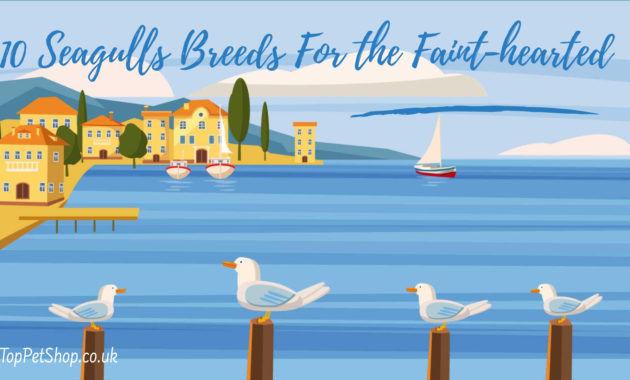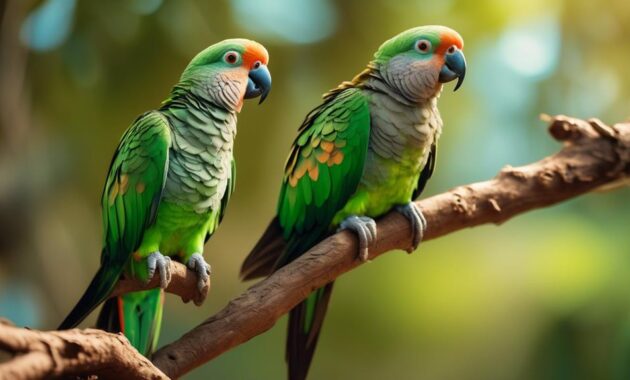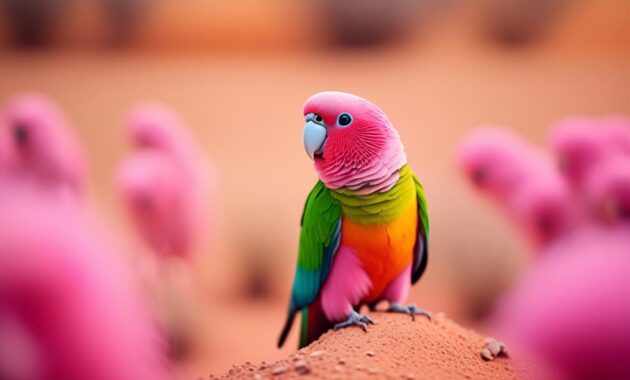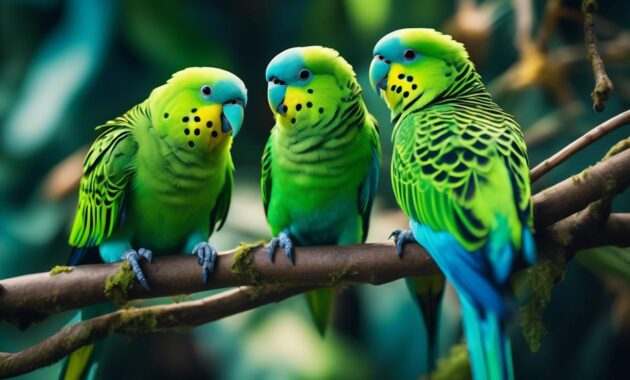
If you think you’ve seen it all when it comes to awe-inspiring birds, think again. Prepare to be amazed as the exquisite Blue Crowned Hanging Parrot takes flight, showcasing its mesmerizing colors and graceful movements.
This avian marvel, known for its vibrant plumage and melodious chirps, will leave you in awe. But that’s just the beginning of this captivating tale.
As you delve deeper into the world of the Blue Crowned Hanging Parrot, you’ll discover its unique characteristics, habitat preferences, and the challenges it faces in the wild. Get ready to be enthralled by this extraordinary creature as we embark on a journey that will leave you yearning for more.
Key Takeaways
- The Blue Crowned Hanging Parrot is a small bird belonging to the Lory family, known for its green feathers with red patches and distinctive blue crown on its head.
- It is native to Southeast Asia, specifically Thailand, Singapore, Malaysia, Burma, and parts of Indonesia, but its habitat is threatened by destruction and illegal capture.
- The Blue Crowned Hanging Parrot shares similarities with the Celestial Parrotlet and Elegant Parrot breeds, and all three have predominantly green feathers with red patches and a blue crown.
- Proper care and maintenance of the Blue Crowned Hanging Parrot include providing a balanced diet, regular check-ups with an avian veterinarian, mental stimulation, and a clean and spacious habitat.
Size and Lifespan
The Blue Crowned Hanging Parrot is a small bird, measuring approximately 5 inches in size, with a lifespan ranging from 15 to 25 years. These vibrant creatures belong to the Lory family and can be compared to breeds such as the Celestial Parrotlet and Elegant Parrot.
Sporting predominantly green feathers, they also have red patches on their lower back and neck, with a distinctive blue crown on their head. When it comes to their calls, these parrots have a quiet, melodic, and pleasant sound.
Native to regions like Thailand, Singapore, Malaysia, Burma, and parts of Indonesia, they thrive in diverse ecosystems like bamboo growths, light forests, and woodland edges. Unfortunately, habitat destruction and illegal capture for the pet market pose significant threats to their survival.
To care for these parrots, provide them with a diet consisting of fresh fruits, green vegetables, and a commercial seed mix. Regular hygiene, which includes daily food and water replacement, clean cages, and regular bathing, is also vital. Additionally, untreated branches can aid in wearing down their nails, and they require ample space for flight and exercise.
Bird Species and Comparable Breeds

Now let’s explore the different bird species and comparable breeds to the Blue Crowned Hanging Parrot.
This stunning parrot belongs to the Lory family and shares similarities with the Celestial Parrotlet and Elegant Parrot breeds.
While the Blue Crowned Hanging Parrot is predominantly green with red patches on its lower back and neck, it stands out with a striking blue crown on its head.
In terms of sound, its natural calls are quiet, melodic, and pleasant.
Found in Thailand, Singapore, Malaysia, Burma, and parts of Indonesia, these parrots thrive in diverse ecosystems such as bamboo growths, light forests, and woodland edges.
However, habitat destruction and illegal capture for the pet market pose significant threats to their survival.
Colors and Sounds

To truly appreciate the Blue Crowned Hanging Parrot, one must admire its vibrant colors and delightful sounds.
Colors of the Blue Crowned Hanging Parrot:
- Predominantly green with red patches on lower back and neck.
- Blue crown on the head.
Sounds of the Blue Crowned Hanging Parrot:
- Natural calls are quiet, melodic, and pleasant.
The Blue Crowned Hanging Parrot is a visual and auditory treat. Its lush green plumage is accentuated by stunning red patches on its lower back and neck. And let’s not forget the regal blue crown on its head, which adds a touch of elegance to its appearance.
But the beauty of the Blue Crowned Hanging Parrot isn’t just skin deep. When it opens its beak, it treats us to a symphony of sounds. Its natural calls are soft, melodic, and oh so pleasant to the ears.
Native Region and Natural Habitat

As we explore further into the Blue Crowned Hanging Parrot’s fascinating characteristics, let’s now shift our focus to its native region and natural habitat.
These exquisite birds are native to Thailand, Singapore, Malaysia, Burma, and parts of Indonesia. They thrive in diverse ecosystems such as bamboo growths, light forests, and woodland edges.
However, their natural habitat is under threat due to habitat destruction and illegal capture for the pet market. It’s crucial to protect these areas to ensure the survival of the Blue Crowned Hanging Parrot population.
Threats to the Blue Crowned Hanging Parrot

Habitat destruction and illegal capture pose significant threats to the Blue Crowned Hanging Parrot population. As a bird enthusiast, it’s important for you to understand the challenges these beautiful parrots face. Here are four key threats that endanger the survival of the Blue Crowned Hanging Parrot:
- Deforestation: The destruction of their natural habitat due to deforestation reduces the availability of suitable nesting sites and food sources for the parrots.
- Agriculture Expansion: The expansion of agricultural activities, such as palm oil plantations, encroaches upon the parrot’s habitat, further limiting their ability to find suitable areas for nesting and foraging.
- Illegal Capture for the Pet Trade: Blue Crowned Hanging Parrots are highly sought after in the illegal pet trade due to their vibrant colors and pleasant calls. As a result, many of these parrots are captured and sold illegally, leading to a decline in their population.
- Climate Change: Changes in climate patterns can disrupt the parrot’s habitat and affect their ability to find food and reproduce.
Care and Feeding

Ensure the well-being of your Blue Crowned Hanging Parrot by providing proper care and nutrition.
To keep your parrot healthy and happy, it’s essential to provide a well-balanced diet. In the wild, these parrots feed on fruits, insects, and seeds. In captivity, you can replicate their diet by offering fresh fruits, green vegetables, and a commercial seed mix.
Make sure to replace their food and water daily to maintain hygiene. Additionally, clean their cages regularly and provide them with opportunities for bathing. To keep their nails in check, provide untreated branches for them to perch on and wear down their nails naturally.
Health and Common Conditions

To maintain the overall well-being of your Blue Crowned Hanging Parrot, it’s important to be aware of its health and common conditions. Here are four key points to consider:
- Regular check-ups: Schedule routine visits with an avian veterinarian to monitor your parrot’s health and detect any potential issues early on.
- Balanced diet: Provide a well-rounded diet consisting of fresh fruits, green vegetables, and a commercial seed mix. Avoid feeding your parrot avocado, chocolate, caffeine, and alcohol, as these can be harmful.
- Mental stimulation: Engage your parrot with toys, puzzles, and interactive play to keep them mentally stimulated and prevent boredom and behavioral issues.
- Watch for signs of illness: Be vigilant for signs of illness such as changes in appetite, behavior, or droppings, sneezing, discharge from the eyes or nose, or feather abnormalities. If you notice any of these, seek veterinary care promptly.
Diet in the Wild

In the wild, the Blue Crowned Hanging Parrot sustains itself on a diet consisting of fruits, insects, and seeds. These small, vibrant birds are opportunistic feeders, foraging for a variety of food sources to meet their nutritional needs.
Fruits, such as berries and figs, provide them with essential vitamins and antioxidants. Insects, including beetles and caterpillars, offer a valuable source of protein. Seeds, especially from trees like palms and acacias, contribute to their energy requirements.
The Blue Crowned Hanging Parrot’s diet isn’t only diverse but also plays a crucial role in their overall health and well-being. By consuming a wide range of foods, they’re able to obtain the necessary nutrients for growth, reproduction, and survival in their natural habitat.
Diet in Captivity

After discussing the Blue Crowned Hanging Parrot’s diet in the wild, let’s now explore its dietary needs when kept in captivity. Here are the key factors to consider:
- Fresh fruits: Provide a variety of fruits such as apples, bananas, and grapes. These should be washed and cut into small pieces to ensure easy consumption.
- Green vegetables: Offer a mix of leafy greens like spinach, kale, and lettuce. These provide essential vitamins and minerals for the parrot’s overall health.
- Commercial seed mix: Choose a high-quality seed mix specifically formulated for parrots. This will ensure a well-balanced diet and provide the necessary nutrients.
- Supplements: Consider adding calcium and vitamin D3 supplements to support bone health and prevent deficiencies.
Remember to consult with an avian veterinarian to determine the specific dietary requirements of your Blue Crowned Hanging Parrot. Providing a varied and nutritious diet will contribute to its overall well-being in captivity.
Hygiene and Cage Maintenance

Regular cleaning and maintenance of the cage is essential for ensuring the health and well-being of your Blue Crowned Hanging Parrot.
It’s important to clean the cage regularly to prevent the buildup of dirt, droppings, and bacteria. Start by removing any uneaten food, feathers, and debris from the cage.
Next, wash the cage with a mild soap and water solution, making sure to scrub all surfaces thoroughly. Rinse the cage well and allow it to dry completely before putting your parrot back in.
Additionally, make sure to regularly replace the bedding or lining of the cage to keep it clean and fresh.
Nail Care

To keep your Blue Crowned Hanging Parrot’s nails healthy and well-maintained, it’s important to regularly provide untreated branches for them to naturally wear down their nails. Here are some important tips to remember for nail care:
- Branches: Offer branches from safe, non-toxic trees for your parrot to perch on. This will help them naturally wear down their nails as they climb and move around.
- Size: Ensure that the branches are of varying sizes and thicknesses. This will help exercise their feet and provide a more comfortable grip.
- Replacement: Regularly replace the branches as they become worn down or soiled. This will keep the environment clean and prevent any potential foot problems.
- Supervision: Always supervise your parrot while they’re perching on the branches. This will help prevent any accidents or injuries.
Behavior and Temperament

When providing nail care for your Blue Crowned Hanging Parrot, it’s important to understand their behavior and temperament. These parrots are known for their calm, friendly, and sociable nature. They’re generally easy to handle and enjoy interacting with their human companions.
Blue Crowned Hanging Parrots require ample space for flight and exercise, so it’s crucial to provide them with a spacious cage or an aviary where they can stretch their wings and stay active. They thrive on social interaction and enjoy being part of a flock, whether it consists of other parrots or humans.
It’s essential to spend quality time with your Blue Crowned Hanging Parrot to keep them mentally stimulated and happy. By understanding their behavior and temperament, you can create a harmonious and fulfilling relationship with your feathered friend.
Space and Exercise Requirements

To ensure the well-being of your Blue Crowned Hanging Parrot, it’s crucial to provide them with sufficient space and opportunities for exercise. Here are four important considerations to keep in mind:
- Cage size: Your Blue Crowned Hanging Parrot needs a spacious cage that allows them to move around freely. The ideal cage size should be at least 30 inches wide, 18 inches deep, and 36 inches high.
- Flight time: These parrots require daily flight time outside of their cage to stretch their wings and exercise. Aim for a minimum of two hours of supervised flight time in a bird-safe area.
- Toys and perches: Provide a variety of toys and perches in the cage to keep your parrot mentally stimulated and physically active. Include different textures, shapes, and sizes to encourage exploration and play.
- Environmental enrichment: Create an enriched environment by offering foraging opportunities, such as hiding treats or food in puzzle toys. This will stimulate your parrot’s natural foraging instincts and keep them mentally engaged.
Characteristics of the Blue Crowned Hanging Parrot

Now let’s explore the distinctive traits of the Blue Crowned Hanging Parrot.
This vibrant parrot species is approximately 5 inches in size and has a lifespan of 15-25 years. Belonging to the Lory family, it’s comparable to breeds such as the Celestial Parrotlet and Elegant Parrot.
The Blue Crowned Hanging Parrot is predominantly green with red patches on its lower back and neck, and it has a striking blue crown on its head. Its natural calls are quiet, melodic, and pleasant.
Native to Thailand, Singapore, Malaysia, Burma, and parts of Indonesia, these parrots thrive in diverse ecosystems such as bamboo growths, light forests, and woodland edges. However, their habitat is threatened by destruction and illegal capture for the pet market.
Conservation Efforts and Future Outlook

Conservation organizations and wildlife authorities have been implementing various measures to protect the Blue Crowned Hanging Parrot and ensure its future survival. These efforts include:
- Habitat Conservation: Protecting and preserving the diverse ecosystems where the parrots thrive, such as bamboo growths, light forests, and woodland edges.
- Anti-Poaching Initiatives: Enforcing strict laws against the illegal capture and trade of Blue Crowned Hanging Parrots, which are highly sought after in the pet market.
- Awareness Campaigns: Educating local communities and raising awareness about the importance of conserving this exquisite bird species and its natural habitat.
- Research and Monitoring: Conducting scientific studies to understand the population dynamics, behavior, and threats faced by the parrots, in order to develop effective conservation strategies.
With these ongoing conservation efforts, there’s hope for the future of the Blue Crowned Hanging Parrot. However, continued support and collaboration are crucial to ensure the long-term survival of this beautiful species.
Frequently Asked Questions
What Is the Average Wingspan of the Blue Crowned Hanging Parrot?
The average wingspan of the blue crowned hanging parrot is approximately 8-9 inches. Their small size and graceful flight make them a delightful sight as they soar through the air.
How Long Does It Take for a Blue Crowned Hanging Parrot to Reach Maturity?
It takes a blue crowned hanging parrot about 1 to 2 years to reach maturity. During this time, they undergo physical and behavioral changes, becoming fully grown and capable of reproducing.
Are There Any Known Predators of the Blue Crowned Hanging Parrot in Its Natural Habitat?
In its natural habitat, the blue crowned hanging parrot faces threats from predators such as snakes, birds of prey, and larger mammals. These predators pose a danger to the parrot’s survival and well-being.
Can Blue Crowned Hanging Parrots Mimic Human Speech?
Yes, blue crowned hanging parrots can mimic human speech. They are known for their ability to imitate various sounds, including words and phrases. It’s one of the reasons why they are popular as pets.
Are Blue Crowned Hanging Parrots Commonly Kept as Pets?
Blue Crowned Hanging Parrots are commonly kept as pets due to their calm and friendly nature. They require space for flight and exercise, a diet of fresh fruits and vegetables, and regular hygiene maintenance.
Are Blue Crowned Hanging Parrots Similar in Temperament to Turquoise Rumped Parrotlets?
Yes, the charming turquoise rumped parrotlet and the blue crowned hanging parrot share similar temperaments. Both species are known to be affectionate, playful, and intelligent. They also have a strong bond with their human companions and enjoy social interaction. However, each bird may have its own unique personality traits.
Conclusion
In conclusion, the Blue Crowned Hanging Parrot is a magnificent bird species with vibrant colors and melodious sounds. Native to Southeast Asia, this parrot faces threats from habitat destruction and illegal capture.
However, with proper care and conservation efforts, we can help protect these beautiful creatures. By understanding their behavior, providing adequate space and exercise, and ensuring their health and well-being, we can contribute to the future outlook of the Blue Crowned Hanging Parrot.
Let’s work together to preserve the enchanting world of these exquisite birds.




